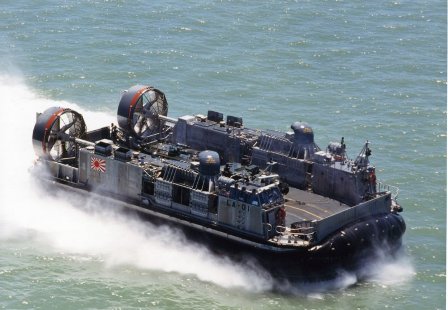Landing Craft Air Cushion-class (LCAC)
Summary
| Origin country | 🇺🇸 United States |
| Category | Amphibious vessel |
| Subtype | Air cushioned landing craft |
| Manufacturer | Textron / Avondale |
| Year commissioned | 1986 |
Description
The Landing Craft Air Cushion (LCAC) is a type of hovercraft utilized by the United States Navy and the Japan Maritime Self-Defense Force (JMSDF) to transport weapons, equipment, cargo, and personnel from ships to shore and across the beach. Eventually, the LCAC will be phased out and replaced by the Ship-to-Shore Connector (SSC) in the U.S. service.
Developed from two prototypes, JEFF A by Aerojet General and JEFF B by Bell Aerospace, the final design that was chosen for production was based on JEFF B, which featured two ducted rear propellers. It was first delivered to the Navy in 1984, achieved Initial Operational Capability in 1986, and entered full production in 1987. The final LCAC was delivered in 2001, with Lockheed Shipbuilding Company later becoming a second source for the construction of the vessels.
The LCAC embarked on its first deployment aboard the USS Germantown in 1987 and has since operated from a variety of U.S. Navy amphibious-well deck ships. Its active fleet is distributed between two coasts at Little Creek, Virginia, and Camp Pendleton, California.
Designed for versatility, the LCAC operates with a five-person crew and supports a range of missions including beach landings, personnel transport, evacuation support, lane breaching, mine countermeasure operations, and equipment delivery. With a cargo capacity of 1,809 square feet, it can transport up to a 60 short-ton payload, including heavy equipment like an M-1 Abrams tank. Despite its vast capabilities, it requires extensive space for maneuvers and generates high noise and dust levels. If the craft becomes disabled, it is challenging to tow.
To extend their service life, a Service Life Extension Program (SLEP) began in 2000 to extend the lifespan of the LCAC from 20 to 30 years for 72 active crafts. Phases of SLEP include replacing electronic components with commercial off-the-shelf (COTS) equivalents, buoyancy box replacements to improve corrosion resistance, and incorporating modern equipment compatible with future joint system technologies. Upgrades also focus on the 'C4N' components and seek to improve engine performance, reduce fuel consumption, and replace skirts to decrease drag and maintenance demands. As of September 2012, 80 LCACs were in the U.S. Navy's possession, with the SLEP conversion process set to continue until 2020. However, the inventory is projected to decline until 2023 when the new SSCs are set to increase numbers.
The Japan Maritime Self-Defense Force operates six LCACs, with their acquisition approved by the U.S. Government in 1994. These crafts were constructed by Textron Marine & Land Systems in New Orleans.
The leading operators of the LCAC are the United States Navy with 74 units across various units, and the Japan Maritime Self-Defense Force with 6 units.
Technical specifications
| Landing Craft Air Cushion | |
|---|---|
| Displacement | 184 tons |
| Range | 300 km at 35 knots |
| Width | 14.3 m (46.9 ft) |
| Length | 26.8 m (87.9 ft) |
| Propulsion | 4 Avco-Lycoming TF 40B gas turbines with a power of 15,820 hp each |
| Thrust | 120 hp |
| Armament | 1 rotating GAU-13 30mm cannon |
| Maximum speed | 54 knots |
Photo of Landing Craft Air Cushion class
